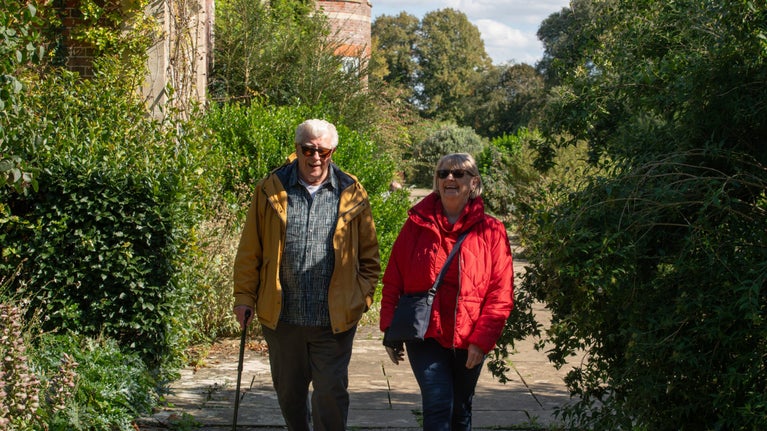
Become a member
Join today and help protect nature, beauty and history – for everyone, for ever. Enjoy access to more than 500 places with National Trust membership.
Rolling hills, distant views, chalk grassland, and acres of woodland to explore
Chilterns Countryside, c/o Hughenden estate, High Wycombe, Buckinghamshire, HP14 4LA

All sites have steep slopes and rough paths. Coombe Hill: surfaced paths suitable for wheelchairs.
Free parking is available but it does get busy at weekends so please arrive early to avoid disappointment. Nearest postcode is HP17 0UR.
Bradenham Estate
Free parking is available in Bradenham village (HP14 4HF) There are parking spaces opposite the cricket pavilion in the village. There's also a small NT car park located on Smalldean Lane (HP27 0PR) which is 1.5 miles north of Bradenham village.
Watlington Hill
Pay and display parking (free to NT members) is available in the National Trust car park at the top of Hill Road. For SatNav users, please use postcode OX49 5HS.
The nearest railway station is Wendover, on the Chiltern line. Follow the ridge way long distance footpath to Coombe Hill (west of Wendover)
Bradenham Estate
Nearest train station to the Bradenham Estate is Saunderton, on the Chiltern line, 1 mile from the village.
Watlington Hill
Nearest train station to Watlington Hill is Henley-on-Thames (10 miles away)
Chilterns Countryside, c/o Hughenden estate, High Wycombe, Buckinghamshire, HP14 4LA
Farmland views and beech woodlands surrounding a village green. See the 11th-century church and 17th-century (private) manor house.
The highest viewpoint in the Chilterns with a Boer War monument. Chalk grassland with wildflowers and butterflies. Natural play area.
Area of rare chalk grassland, especially good for watching red kites flying overhead. Iconic, triangular chalk white mark and woodland.
Discover the countryside sites of the Chilterns. Find the best viewpoints, walk through ancient woodland or pick a quiet spot to watch for wildlife.

Explore the walking trails, play area and wildlife of Coombe Hill, the highest point in the Chiltern Hills.

Discover scenic Bradenham. Look for wildlife and hidden archaeology in the ancient woodland or set out to explore the picturesque village.

The wonderful views, rich chalk grassland and downland of Watlington Hill make it a perfect place for walks and wildlife spotting.

Discover Aston Wood and Juniper Bank in the Chiltern Hills. These woodland sites are ripe for exploring, with wildlife to spot and trails to follow.

Explore the ancient remains of a hidden Iron Age hillfort in this atmospheric woodland.

Explore the atmospheric woodland of Low Scrubs, encountering relics of its ancient past from as far back as the early Iron Age, on this short waymarked walk.

Explore the Aston Rowant National Nature Reserve, along with the National Trust woodlands at nearby Juniper Bank and Aston Wood.

This is a long and fairly challenging walk taking you around Watlington Hill, Pyrton Hill, Cowleaze Wood and the Wormsley Estate.

Discover the ups and downs of the valleys that carve their way through the Chiltern Hills on this challenging circular trail, which starts from West Wycombe and explores the surrounding woodland, farmland, and villages.

Enjoy a moderately energetic circular walk from Coombe Hill, taking in views across the Aylesbury Vale. You'll wander through woodlands, past rare chalk grassland and the pretty village of Ellesborough.

This circular Thames walk takes in a historic watermill, the Henley Regatta course, views across the Thames Valley and quiet stretches of river with the chance to spot wildlife.

Follow this gentle circular trail in the Chilterns through beech woodland to the top of Coombe Hill, with far-reaching views from its summit.

Discover a challenging 8½-mile scenic walk linking three National Trust places in the Chiltern Hills: West Wycombe, Bradenham and Hughenden. Longer and shorter routes can be completed depending on your choice.

Enjoy a classic Chilterns landscape and find out more about the history of this part of the world on the Bradenham beech woods walk.

Explore the wooded valleys of the Chiltern Hills on this 9.5-mile circular walk, passing through some of the area's prettiest villages.

This walk offers memorable views over the Vale of Oxford and Chiltern Escarpment, as well as abundant wildlife and birdlife amongst the site's chalk grassland and woodland habitats.

Visit rural hamlets, stroll through beech woods and enjoy views across the Hambleden Valley on the Hambleden and Pheasant’s Hill trail.

Sorry, there are no upcoming events at this place
Situated in the picturesque Chiltern Hills, this group of popular beauty spots offers fabulous walking opportunities. Pleasant day long walks with a pub stop can take you through the intimate landscape of woods, farms and hamlets that make up much of the Chilterns.
The largest sites include Coombe Hill near Wendover, which has far-reaching views over Aylesbury Vale. Bradenham Estate, between West Wycombe and Princes Risborough, is a pretty village and patchwork of woodland and chalk grassland. Watlington Hill and Woods is at the top of an escarpment where red kites and ravens soar and play over views of Oxfordshire stretching into the distance.
Smaller sites worth exploring include Pulpit Hill and Low Scrubs near Wendover, and Aston Wood and Juniper Bank near Stokenchurch.
The countryside of the Chiltern Hills is steeped in history. Explore the past of some of our sites, from royal visits to ancient hillforts.

Find out more about our work to manage ancient woodlands, hedgerows and meadows to create a diverse habitat that enables a wide variety of wildlife to thrive.

Search for live volunteering opportunities, or register your interest with Chilterns Countryside.


Join today and help protect nature, beauty and history – for everyone, for ever. Enjoy access to more than 500 places with National Trust membership.
By sharing your email address you’re agreeing to receive marketing emails from the National Trust and confirm you’re 18 years old or over. Please see our for more information on how we look after your personal data.